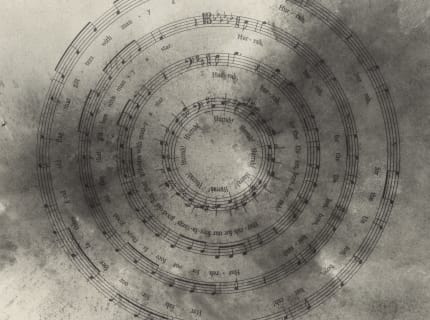Bethany Collins stood in the middle of the gallery, gesturing at three long off-white drawings. Each had been smeared from top to bottom; nearly every stroke was smudged.
“It’s my spit,” she explained.
Each piece was a replica of a page from Homer’s “Odyssey,” each work a different translation of the same passage. Collins had copied the pages onto canvases, perfecting every curve of every font, capturing the width of every space and margin; she re-created the pages exactly, only larger. Then, when finished, she spit on them, smudging lines until the passages became illegible streaks.
Water would have worked, she said, but saliva is more acidic — it leaves a texture, a residue. “And the residue of language,” she said with a smile, “that’s kind of become my thing.”
From a distance, the drawings are abstractions, blurry and amorphous. Move closer, you pick up fragments of lettering beneath the smudges, serifs and bits of typography that resemble fractured hieroglyphics of an extraterrestrial civilization. Closer still, you realize: Oh, wait, no, that is English, she’s just erased every trace of comprehension.
“Everything,” Collins said, “but words I want you to read.”
Indeed, tucked amid smudges, hard to see, are sentences, not originally sequential, brought together now through erasure. All that remained on one drawing, separated by long crossed-out bits, was: “What land is this? What people? What men are born here?”
“It’s from the part of Book 13 where Odysseus returns to his homeland,” she said, “And everything about his country looks familiar, and yet it all feels somehow strange now. When I read that, I thought, ‘That sounds a lot like the political moment in this country.”
Collins, a rising conceptual artist who has been based in Chicago for the past couple of years, is among the savviest practitioners of erasure, a technique typically associated with visual arts and poetry in which an artist creates absence, often removing pieces from another, completed work. In both cases, the result is a creative act of destruction — “an additive subtraction,” as artist Jasper Johns once described erasure. Depending on your vantage, it also looks like an act of revelation, censorship, appropriation or plain-old artistic revenge. The endgame, though, is the same: picking away at a text to find the art beneath the art, showing another meaning or reading that had been waiting there all along, revealing how a set of words can mean different things to different people.
Collins’ new show — at the Patron Gallery in West Town through Oct. 28 — is titled “Undersong” and features three sets of works: the “Odyssey” pieces; a series of classified ads once placed in 19th-century black newspapers by former slaves looking for the family they had been separated from; and paintings of patriotic American songs, including “America the Beautiful” and “My Country, ’Tis of Thee.” The “Odyssey” drawings, she said, “felt like the story we tell about ourselves, the classified ads felt like the actual story of who we are, and the songs, those are like a vision of a future that could be — yet probably never will really be, because of course, the future is always us.”
Disparate as it sounds, what binds the show — other than being conceived, like so much of contemporary art now, as a response to Donald Trump’s presidency — is a fascination with the malleableness of words, and a paradoxical urge to erase most of those words.
From a distance, the song paintings look like constellations, snowflakes, feathers; the ads look like simple, monochromatic sheets of paper. Closer, you see the ads are stripped of printed type but rather imprints of type; and the song paintings are full of smudges, with phrases and words redrawn over and over, into knotty, abstracted swirls.
“My work often deals with language and race,” Collins said, “and since I find language frustrating, erasure works well here. I want you to be frustrated — not with the work but with trying to read it. (Erasure) makes me feel I can control a text that feels out of my hands. By the time I have written something a thousand times, or spit and erased a ton of sentences, I feel a physical mastering of language. By deciding what’s legible, I’m dragging out the meaning already there. Erasure, for me, means a nice sharp elbow.”
...
Read full article at chicagotribune.com.

